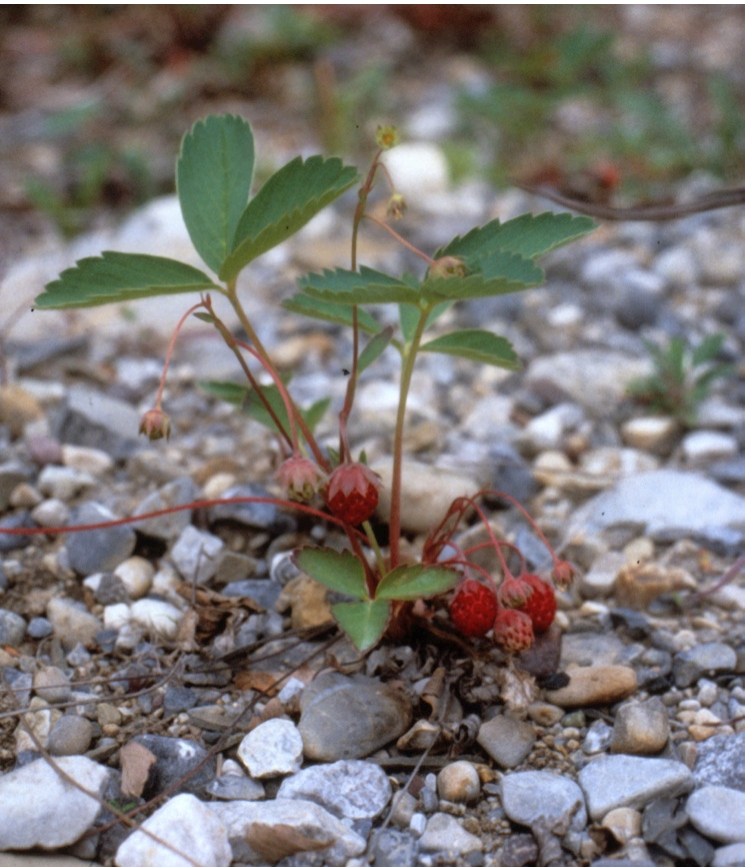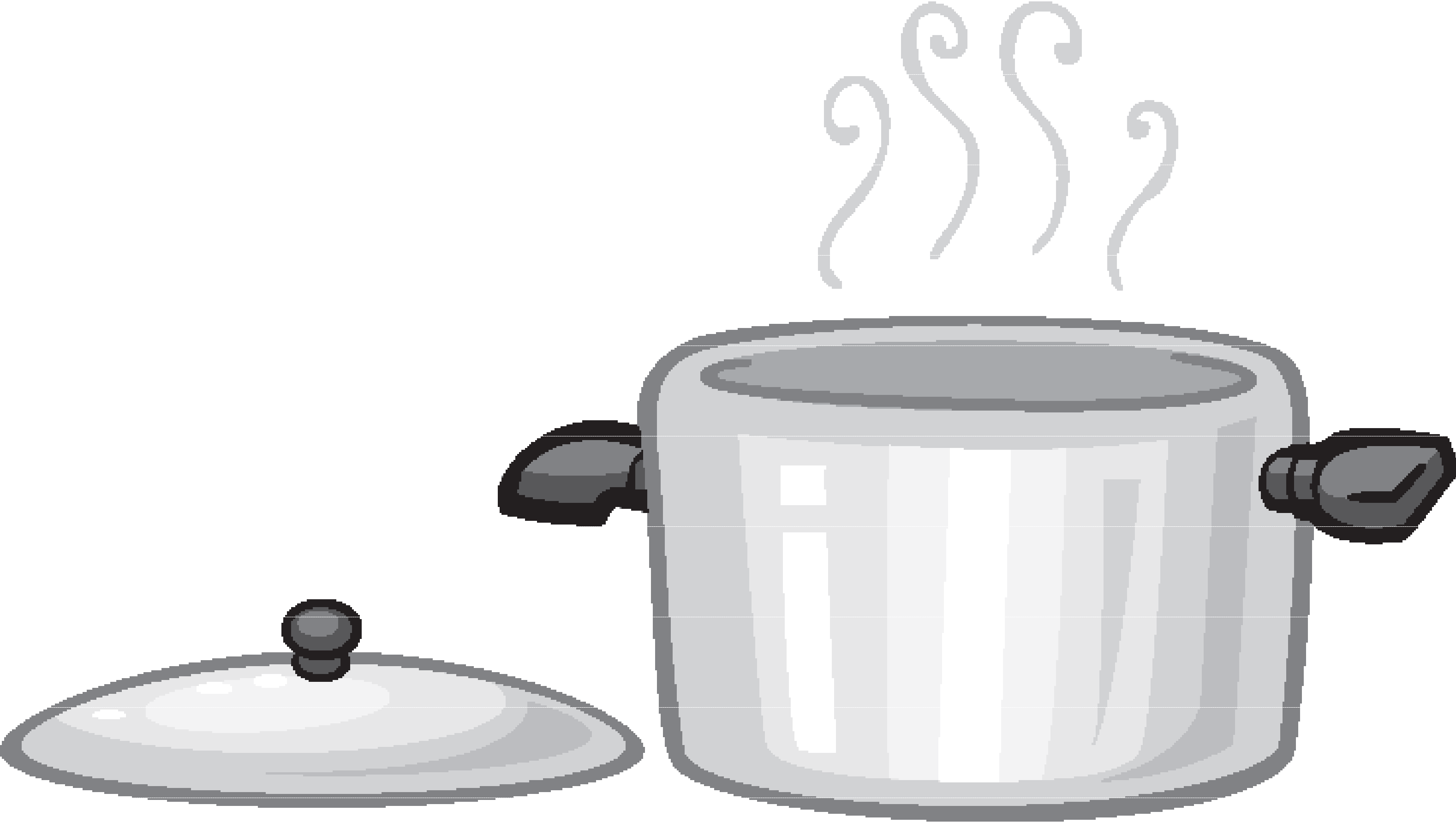Wild Strawberries
FNH-00105 View this publication in PDF form to print or download.
Alaska wild strawberry plants have saw-toothed leaves with three leaflets that grow on long, slender stalks. The red berries are fleshy, sweet and juicy. They are similar to commercially grown strawberries but are smaller.
Alaska wild strawberries are found scattered throughout Southeast Alaska, Interior Alaska, the Gulf Coast of Alaska, the Seward Peninsula and the Aleutians. Wild strawberries should be picked when fully ripe and are usually available in late June or July. They can be eaten fresh or may be used in syrups, toppings, jams, jellies, preserves, pies and other recipes calling for fresh strawberries.
Storage and Preservation
How to Clean and Store
Store unwashed strawberries in a covered container in the refrigerator for up to one week. Leave the hull on until ready to use or preserve. When ready to use, remove hull, rinse gently and drain in a colander.
How to Freeze
Spread wild strawberries in a single layer on a cookie sheet and place in the freezer. When frozen, transfer the berries to freezer bags or containers. Properly frozen, strawberries will last up to two years.
How to Dry
Wild strawberries are seedy when dried. Cut strawberries in half. Cover a flat tray with cheesecloth or light muslin. Spread the berries on the cloth, skin side down; place the tray in the sun in a location that can be protected from birds and animals. To dry berries in a dehydrator, spread on open screen and dry as for other fruits, following directions for the dehydrator. Oven drying is possible, but very low heat (140°F) must be used and the oven door must be left ajar so moisture can escape. Store in a cool, dry place. Dried berries may be sprinkled on cereal, combined with granola, mixed in yogurt or eaten as a snack.
How to Extract Juice
Wash and crush berries. Combine 10 cups crushed berries and 1½ cups water in a large saucepan. Bring to a simmer, cover and simmer for 10 minutes. Place in jelly bag or in layers of cheesecloth in a colander. Let the juice drip into a bowl. For clear juice, do not twist or press the jelly bag or cheesecloth. For long-term storage, the juice should be frozen or canned.
Yield: 6 cups
Hot pack for juice
Sterilize canning jars. Heat juice, stirring occasionally, until it begins to boil. Pour into hot jars, leaving ¼ inch headspace. Wipe jar rims. Adjust lids. Process in a boiling water canner.
- Pints or quarts: 5 minutes
- Half gallons: 10 minutes
How to Prepare Puree
Cooked method: Add 1 cup of water to 4 cups of wild strawberries. Cook until soft. Press through sieve or food mill.
Yield: 2 cups
Uncooked method: Rinse 4 cups of wild strawberries, drain, put in a blender and blend until the consistency of a thick puree.
Yield: 2 cups
To freeze, pack into rigid containers leaving ½ inch headspace for expansion. Seal and freeze.
To can, fill hot jars with hot puree, leaving ¼ inch headspace. Process quarts, pints, or half-pints in a boiling water bath for 15 minutes.
Recipes
Wild Strawberry Syrup
- 1 cup wild strawberry juice
- 2 cups sugar
- 1 teaspoon lemon juice
Combine all ingredients in a saucepan; heat to 160°F. Use a candy thermometer; do not boil. The syrup is ready to use over waffles, pancakes, hot biscuits, ice cream and other desserts. The syrup will keep up to six months in the refrigerator without sugaring.
For long-term storage: Sterilize pint or half-pint canning jars and prepare lids; immediately pour hot syrup into hot canning jars, leaving ¼ inch headspace. Wipe jar rims and add prepared two-piece lids. Process 5 minutes in a boiling water bath.
Yield: 2 cups
Wild Strawberry Rhubarb Fruit Leather
- 1 cup wild strawberry puree
- 1 cup rhubarb puree
- 1½ tablespoons honey or corn syrup
Combine purees and sweetener. Line a cookie sheet with plastic wrap. Spread puree mixture evenly about ¹⁄8 to ¼ inch thick over plastic, but do not push it completely to the sides of the cookie sheet. Oven dry at 140°F for approximately 6 hours, leaving oven door slightly open so moisture can escape. Or use a dehydrator and follow manufacturer’s directions for fruit leathers.
Yield: 1 sheet
Rhubarb puree
Wash and cut rhubarb into ½-inch pieces to yield 1 quart of rhubarb (approximately six stalks, 24 inches long and ¾ inch wide). Put ¼ cup water in a saucepan and add rhubarb. Cook only until rhubarb starts to soften. Let cool slightly; put in blender and make into puree.
Yield: 2 cups
Wild Strawberry Jam
- 5 cups wild strawberries, crushed
- 1 package powdered pectin (1¾ ounces)
- 7 cups sugar
Sterilize pint or half-pint canning jars and prepare lids. Measure sugar and set aside. Measure crushed fruit into a large saucepan. Add pectin and stir until dissolved. Bring to a full rolling boil over high heat, stirring constantly. At once, stir in sugar. Stir and bring to a full rolling boil that cannot be stirred down. Boil hard for 1 minute, stirring constantly.
- To sterilize canning jars, boil in water for 5 minutes.
- To prepare two-piece lids (rings and tops), wash, rinse set aside until ready to use. Follow manufacture’s directions for use.
- If less sugar is desired in recipes calling for pectin, be sure to use no-sugar-needed pectin and follow the instructions on the box.
- See later instructions on this page for how to use a boiling water canner.
Remove from heat. Skim off foam. Immediately pour jam into hot jars, leaving ¼ inch headspace. Wipe jar rims and add prepared two-piece lids. Process 5 minutes in a boiling water bath.
Yield: 8 cups
Wild Strawberry Freezer Jam
- 1¾ cups wild strawberries, crushed
- 4 cups sugar
- 2 tablespoons lemon juice
- 3 ounces liquid pectin
Measure prepared fruit into large bowl. Measure sugar and stir into fruit. Set aside for 10 minutes, stirring occasionally. Put liquid pectin into a small bowl and stir in lemon juice. Add pectin mixture to fruit mixture. Stir for 3 minutes. Fill prepared freezer containers to within ½ inch of top. Cover with tight lid. Let stand at room temperature for 24 hours or until set, then place in freezer. After opening, store in refrigerator for up to 3 weeks.
Yield: 4 cups
Wild Strawberry Rhubarb Jelly
- 6 cups cut rhubarb (about 9 stalks)
- 6 cups ripe wild strawberries
- 6 cups sugar
- 3 ounces liquid pectin
To Prepare Juice
Cut washed rhubarb into 1-inch pieces. In a blender or food processor, chop rhubarb pieces until they are the consistency of thick puree. Wash, stem and crush wild strawberries, one layer at a time, in a bowl or saucepan. Place both fruits in a jelly bag or four layers of cheesecloth and gently squeeze out juice (3½ cups of rhubarb strawberry juice are needed).
To Make Jelly
Sterilize pint or half-pint canning jars and prepare lids. Open liquid pectin pouch and stand upright in a cup or glass. Measure 3½ cups rhubarb strawberry juice into a large saucepan. Add sugar and mix well. Place on high heat; stir constantly and bring to a full rolling boil that cannot be stirred down. Add the liquid pectin and heat again to a full rolling boil. Boil hard for 1 minute, stirring constantly. Remove from heat and quickly skim off foam. Immediately pour hot jelly into hot canning jars, leaving ¼ inch headspace. Wipe jar rims and add prepared two-piece lids. Process 5 minutes in a boiling water bath.
Yield: 7 cups
Strawberry Rhubarb Pie
- Pastry for double crust, 9-inch pie (unbaked)
- 2 cups diced rhubarb (about 4 stalks)
- 2 cups wild strawberries, sliced
- ½ cup brown sugar
- 1 cup granulated sugar
- ¼ cup flour
- ½ teaspoon cinnamon
- ¼ teaspoon nutmeg
Line 9-inch pie plate with pastry, leaving a ½-inch overhang. In a bowl, mix together all ingredients and pour into pastry shell. Cover with top crust, flute edge and cut slits in top. Bake at 425°F for 45 to 50 minutes. Remove from oven and cool on a wire rack.
To process in a boiling water canner, follow these steps:
- Fill the canner halfway with water. Preheat water to a low boil. Place filled jars, fitted with lids, into the canner on the rack. Add more boiling water, if needed, so the water level is at least 1 inch above jar tops. Turn heat to its highest position until water boils vigorously. When the water boils, set a timer for the recommended processing time indicated in the recipe. Cover with the canner lid and lower heat setting to maintain a gentle boil throughout the processing time. Add more boiling water, if needed, to keep the water level above the jars.
- When the jars have been boiled for the recommended time, turn off the heat and remove the canner lid. Using a jar lifter, remove the jars and place them on a towel, leaving at least 1 inch of space between the jars during cooling.
- After cooling jars for 12 to 24 hours, remove the screw bands and test seals. Press the middle of the lid with a finger. If the lid springs up when finger is released, the lid is unsealed. If a lid fails to seal on a jar, remove the lid and check the jar-sealing surface for tiny nicks. If necessary, change the jar, add a new, properly prepared lid and reprocess within 24 hours using the same processing time. Alternately, adjust headspace to 1½ inches and freeze or store in the refrigerator and use within three days.
- If lids are tightly sealed on cooled jars, remove screw bands, wash the lid and jar
to remove food residue, then rinse and dry jars. Label and date the jars. Store
in a clean, cool, dark, dry place.

UAF Cooperative Extension Service Resources
Jams and Jellies – Lesson 5, Food Preservation Series, FNH-00562E
Canning Overview – Lesson 2, Food Preservation Series, FHN-00562B
Using Alaska’s Wild Berries and Other Wild Edibles ($15), FNH-00120
Canning Basics DVD ($5), FNH-01280
Jams and Jellies DVD ($5), FNH-01290
Sarah R.-P. Lewis, Extension Faculty, Health, Home and Family Development. Originally written by Roxie Rodgers Dinstel, former Extension Faculty, Health, Home and Family Development, and Marci Johnson, former Program Assistant, Health, Home and Family Developme
Revised May 2021
